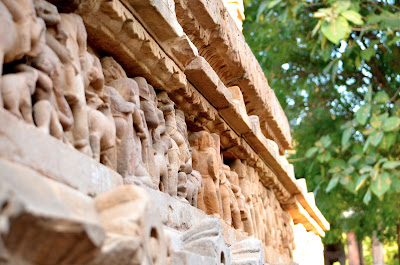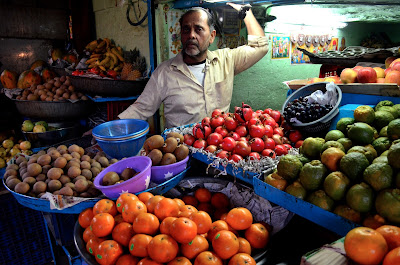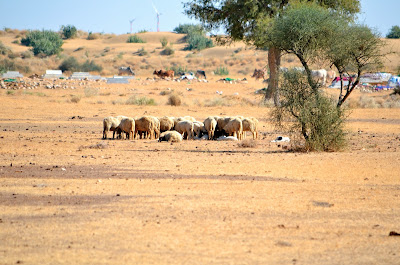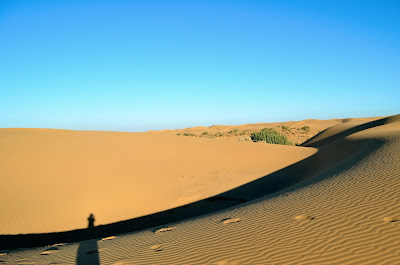After a long hiatus from blogging, my computer is now back in action, and I am back to blogging. Although I can hardly do the past two months - two months! - justice, I will try my best to describe accurately what I've been up to. I left off with the Muslim festival of Bakri Eid, which was shortly followed by the Hindu festival Diwali.
Diwali, popularly called the "festival of lights," commemorates another big event in the Ramayana (see my last blog post's discussion of Dashera): Ram and Sita's return home from Lanka after Ram rescues Sita and kills Raven. In a more general sense, the holiday is Hinduism's celebration of the triumph of good over evil. The festival is observed through the lighting of oil lamps all throughout ones home, as well as in surrounding temples. These lights signify the lights that were lit to guide Ram and Sita home, in addition to being a way of welcoming the goddess Lakshmi - goddess of wealth - in to one's home. Diwali is treated as the Hindu new year - particularly the start of the new fiscal year - and it is traditional to wear new clothing and give gifts and sweets to your family and friends. The festival is actually five days long, and on its biggest night, families celebrate by lighting diyas (oil lamps), eating festive meals, and setting off sparklers and fireworks to drive off evil spirits.
I celebrated Diwali with my family, helping them clean the home and mark each doorway with a rangoli - a beautifully colored, circular design that we stuck on the floor - to invite in Lakshmi, and later, when night descended, we left home with a tray of unlit diyas and walked all around the neighborhood, from temple to temple, as my family lit diyas and said their prayers at the temples' shrines. Nights in Benares are usually eerily quiet and the streets have an almost ghostly quality to them, but on Diwali night, the streets, and particularly the alleyways surrounding my home leading to the Ganga, were bustling with groups of women heading to temple in their best saris and children screeching with delight as they haphazardly lit firecrackers and tiny explosives. Chiming bells from every temple and shrine clamored in the air along with the endless explosion of fireworks that could have you thinking you were in a war zone. Burts of color were around every corner, as well as splattered against the sky.
After returning home from our temple walk - which had been a women's-only event - my family gathered together to do their pooja, treating me like their third child and setting out a cushion in front of the family shrine for me to sit on. Interestingly to me, my mom led the pooja, while the rest of the family followed her lead. It wasn't a long ceremony - I know that other host families had poojas that lasted for hours, whereas mine was no more than fifteen minutes - and ended with a short song, the combination of candle-lighting and singing reminding me a bit of lighting Hannukah candles back at home.
Following pooja was the night's true main attraction. We all went up to the rooftop of my building, a rooftop that dwarfes the surrounding ones, and began to open up the arsenal of fireworks my family had bought. Plunging in to the depths of the box, we went through firework after firework, huge explosives that lit up the sky in cascades of colorful sparks, rivalling even the Boston New Years' fireworks display. There were fireworks that showered sparks like a volcano shooting up lava. There were fireworks shaped like rockets that sometimes made it up in to the sky, but with equal frequency plunged down into the depths of a neighboring street or building. There were whole boxes of fireworks that were lit up at once. There were hundreds of sparklers and tiny noise-making explosives. There were spinning tops that spiraled all accross the floor, shooting out endless streams of sparks that we danced through - and were occasionally burned by. But what seemed to be the biggest, craziest - and, in my opinion, scariest - attraction of the night was the "1,000 explosives" firework: a several foot long strand of exactly 1,000 explosives with an uncanny resemblance to an overgrown ammunition belt. Once it was lit, the air was rocked by minutes of explosions, leaving no doubt that you were right in the middle of a war zone - but then what evil spirits would want to visit a war zone?
After Diwali, the celebrations continued with Thanksgiving and Dev Diwali, a holiday particular to Varanasi in which all the stairs of the ghats for the entire length of the city are covered in lit diyas. Hundreds of thousands of flames burn and the riverbank of the city glows. Where Dev Diwali brings life to the ghats long after it normally ends, Chatta Pooja, another November festival, has the riverbank alive with activity far before it normally begins. On Chatta Pooja, hundreds of thousands of women from Varanasi and from outside the city and neighboring states gather along the Ganga in their best dress, spend the night there, and are up and about when it's still the middle of the night, ready to do pooja to the rising sun. The women - and now, men as well - are packed in on the ghats like sardines, jostling each other and buzzing with anticipation of sunrise. When the first bit of the sun's glowing orb peeks over the horizon, the ghats are an explosion of activity, a blur of color and a blending of sound.
The end of November brought our first excursion out of Varanasi since our arrival two months before. We spent the weekend in Khajuraho, a small town that surrounds an anicent temple complex known for the stunning condition of its buildings and, in part, for its erotic carvings. The carvings on the temples, both their detail and their scale, were awe-inspiring and I could have spent days staring at the millions of different statues and the ever-changing golden-pink hues of the temple's stones glowing beneath the sun.
After several more weeks of work and watching as Varanasi got colder and colder, we left again, this time for our biggest trip of the year, a two week romp through Rajastahan. Rajasthan is the desert state of India and is known for its romantic past full of warring dynasties, maharajas and golden hill-top forts. Our first stop, 27 hours on a train away from Varanasi, was Jodhpur. Jodhpur, also known as the "blue city" because of its many blue-painted homes, is towered over by Mehrangarh Fort, the ancient home of the ruling Rathore dynasty. Sitting atop a craggy hill, the fort is apparently a favorite filming location, having most recently hosted the cast of The Dark Knight Rises. After wandering through the fort, Ada, Mackenzie and I split off from the group and spent the afternoon exploring the narrow alleyways of the Jodhpur market district. We lingered over bangles, drooled over an anomalous mango, chatted with shopkeepers, bargained our way in to scarves and shoes, got a little lost, and found our way again. The colors and characters were captivating and the intimacy and freedom of wandering through unknown streets and alleys made our curiosity feel like an adventure and Jodhpur feel a bit like home.
Our next stop was Jaisalmer, "the golden city." Partially located within the towering walls of an ancient fort, all of Jaisalmer, inside the fort and out, is made of golden sandstone. The city looks like an exotic Disneyland of the Far East, full of intricately carved, adorned buildings, tiny little palaces built just for you and me. The whole thing, fort and all, could have been built just last year as some sort of surreal fantasy-world vacation spot, and yet, it's hundreds and hundreds of years old - the ancient ruling capital of the Rajput clan. We left from Jaisalmer for a camel safari out in the surrounding desert. More than two days of sauntering over sand dunes on our camels' backs left me with no particular love of camels, but with an infatuation for the sun-baked sand dunes and the desert's sparkly night sky. I unfortunately don't have the words to do the dunes, the sunset, or the night sky justice, but try, at least, to picture this: You are sitting on top of a sand dune and can see the entire sky, starting from right above your head and descending down in infinite longitudes, hitting the horizon at every single point on the circle of earth surrounding you. I realized at that moment that I don't think I've ever been able to see 360 degrees of horizon before in my life. It feels, in a way, like being inside a snowglobe. You can see more sky and earth than you knew existed, and you're right in the thick of it, being pushed by the sand dune up to the heavens, as the heavens themselves are dropping down alongside you like a cocoon. And when the sun finally sets and the last traces of sunlight disappear sometime far in the middle of the night, the sky is diamond-studded with stars, so bright that it's practically blinding to look up, and so distracting that, if you do, you'll never get back to sleep.
After Jaisalmer was Jaipur. A huge city much like Delhi, it appeared in stark contrast to the small desert oasis of Jaisalmer. Jaipur was a bit crazy and hectic, its old city stuffed to the brim with people, goods and cars. But just a bit out of the city, Jaipur had its own little oasis, Amer Fort, the largest, most complex fort we saw during the trip. It was full of endless passageways and rooms, carvings and paintings, but its most striking part was the hall of mirrors, a room to rival Versailles' own Hall of Mirrors unquestionably. The ceiling and walls were decorated with millions of tiny mirrors arranged into intricate patterns, and just like the desert's night sky, it was nearly impossible to tear myself away.
Now, though, after two weeks of whirlwind traveling, I'm happy to be back in Benares. Back home.
Diwali, popularly called the "festival of lights," commemorates another big event in the Ramayana (see my last blog post's discussion of Dashera): Ram and Sita's return home from Lanka after Ram rescues Sita and kills Raven. In a more general sense, the holiday is Hinduism's celebration of the triumph of good over evil. The festival is observed through the lighting of oil lamps all throughout ones home, as well as in surrounding temples. These lights signify the lights that were lit to guide Ram and Sita home, in addition to being a way of welcoming the goddess Lakshmi - goddess of wealth - in to one's home. Diwali is treated as the Hindu new year - particularly the start of the new fiscal year - and it is traditional to wear new clothing and give gifts and sweets to your family and friends. The festival is actually five days long, and on its biggest night, families celebrate by lighting diyas (oil lamps), eating festive meals, and setting off sparklers and fireworks to drive off evil spirits.
I celebrated Diwali with my family, helping them clean the home and mark each doorway with a rangoli - a beautifully colored, circular design that we stuck on the floor - to invite in Lakshmi, and later, when night descended, we left home with a tray of unlit diyas and walked all around the neighborhood, from temple to temple, as my family lit diyas and said their prayers at the temples' shrines. Nights in Benares are usually eerily quiet and the streets have an almost ghostly quality to them, but on Diwali night, the streets, and particularly the alleyways surrounding my home leading to the Ganga, were bustling with groups of women heading to temple in their best saris and children screeching with delight as they haphazardly lit firecrackers and tiny explosives. Chiming bells from every temple and shrine clamored in the air along with the endless explosion of fireworks that could have you thinking you were in a war zone. Burts of color were around every corner, as well as splattered against the sky.
After returning home from our temple walk - which had been a women's-only event - my family gathered together to do their pooja, treating me like their third child and setting out a cushion in front of the family shrine for me to sit on. Interestingly to me, my mom led the pooja, while the rest of the family followed her lead. It wasn't a long ceremony - I know that other host families had poojas that lasted for hours, whereas mine was no more than fifteen minutes - and ended with a short song, the combination of candle-lighting and singing reminding me a bit of lighting Hannukah candles back at home.
Following pooja was the night's true main attraction. We all went up to the rooftop of my building, a rooftop that dwarfes the surrounding ones, and began to open up the arsenal of fireworks my family had bought. Plunging in to the depths of the box, we went through firework after firework, huge explosives that lit up the sky in cascades of colorful sparks, rivalling even the Boston New Years' fireworks display. There were fireworks that showered sparks like a volcano shooting up lava. There were fireworks shaped like rockets that sometimes made it up in to the sky, but with equal frequency plunged down into the depths of a neighboring street or building. There were whole boxes of fireworks that were lit up at once. There were hundreds of sparklers and tiny noise-making explosives. There were spinning tops that spiraled all accross the floor, shooting out endless streams of sparks that we danced through - and were occasionally burned by. But what seemed to be the biggest, craziest - and, in my opinion, scariest - attraction of the night was the "1,000 explosives" firework: a several foot long strand of exactly 1,000 explosives with an uncanny resemblance to an overgrown ammunition belt. Once it was lit, the air was rocked by minutes of explosions, leaving no doubt that you were right in the middle of a war zone - but then what evil spirits would want to visit a war zone?
After Diwali, the celebrations continued with Thanksgiving and Dev Diwali, a holiday particular to Varanasi in which all the stairs of the ghats for the entire length of the city are covered in lit diyas. Hundreds of thousands of flames burn and the riverbank of the city glows. Where Dev Diwali brings life to the ghats long after it normally ends, Chatta Pooja, another November festival, has the riverbank alive with activity far before it normally begins. On Chatta Pooja, hundreds of thousands of women from Varanasi and from outside the city and neighboring states gather along the Ganga in their best dress, spend the night there, and are up and about when it's still the middle of the night, ready to do pooja to the rising sun. The women - and now, men as well - are packed in on the ghats like sardines, jostling each other and buzzing with anticipation of sunrise. When the first bit of the sun's glowing orb peeks over the horizon, the ghats are an explosion of activity, a blur of color and a blending of sound.
 |
| Chatta Pooja |
 |
| Dev Diwali |
The end of November brought our first excursion out of Varanasi since our arrival two months before. We spent the weekend in Khajuraho, a small town that surrounds an anicent temple complex known for the stunning condition of its buildings and, in part, for its erotic carvings. The carvings on the temples, both their detail and their scale, were awe-inspiring and I could have spent days staring at the millions of different statues and the ever-changing golden-pink hues of the temple's stones glowing beneath the sun.
After several more weeks of work and watching as Varanasi got colder and colder, we left again, this time for our biggest trip of the year, a two week romp through Rajastahan. Rajasthan is the desert state of India and is known for its romantic past full of warring dynasties, maharajas and golden hill-top forts. Our first stop, 27 hours on a train away from Varanasi, was Jodhpur. Jodhpur, also known as the "blue city" because of its many blue-painted homes, is towered over by Mehrangarh Fort, the ancient home of the ruling Rathore dynasty. Sitting atop a craggy hill, the fort is apparently a favorite filming location, having most recently hosted the cast of The Dark Knight Rises. After wandering through the fort, Ada, Mackenzie and I split off from the group and spent the afternoon exploring the narrow alleyways of the Jodhpur market district. We lingered over bangles, drooled over an anomalous mango, chatted with shopkeepers, bargained our way in to scarves and shoes, got a little lost, and found our way again. The colors and characters were captivating and the intimacy and freedom of wandering through unknown streets and alleys made our curiosity feel like an adventure and Jodhpur feel a bit like home.
 |
| Jodhpur, The Blue City |
 |
| Mehrangarh Fort |
Our next stop was Jaisalmer, "the golden city." Partially located within the towering walls of an ancient fort, all of Jaisalmer, inside the fort and out, is made of golden sandstone. The city looks like an exotic Disneyland of the Far East, full of intricately carved, adorned buildings, tiny little palaces built just for you and me. The whole thing, fort and all, could have been built just last year as some sort of surreal fantasy-world vacation spot, and yet, it's hundreds and hundreds of years old - the ancient ruling capital of the Rajput clan. We left from Jaisalmer for a camel safari out in the surrounding desert. More than two days of sauntering over sand dunes on our camels' backs left me with no particular love of camels, but with an infatuation for the sun-baked sand dunes and the desert's sparkly night sky. I unfortunately don't have the words to do the dunes, the sunset, or the night sky justice, but try, at least, to picture this: You are sitting on top of a sand dune and can see the entire sky, starting from right above your head and descending down in infinite longitudes, hitting the horizon at every single point on the circle of earth surrounding you. I realized at that moment that I don't think I've ever been able to see 360 degrees of horizon before in my life. It feels, in a way, like being inside a snowglobe. You can see more sky and earth than you knew existed, and you're right in the thick of it, being pushed by the sand dune up to the heavens, as the heavens themselves are dropping down alongside you like a cocoon. And when the sun finally sets and the last traces of sunlight disappear sometime far in the middle of the night, the sky is diamond-studded with stars, so bright that it's practically blinding to look up, and so distracting that, if you do, you'll never get back to sleep.
After Jaisalmer was Jaipur. A huge city much like Delhi, it appeared in stark contrast to the small desert oasis of Jaisalmer. Jaipur was a bit crazy and hectic, its old city stuffed to the brim with people, goods and cars. But just a bit out of the city, Jaipur had its own little oasis, Amer Fort, the largest, most complex fort we saw during the trip. It was full of endless passageways and rooms, carvings and paintings, but its most striking part was the hall of mirrors, a room to rival Versailles' own Hall of Mirrors unquestionably. The ceiling and walls were decorated with millions of tiny mirrors arranged into intricate patterns, and just like the desert's night sky, it was nearly impossible to tear myself away.
 |
| Amer Fort |
 |
| Traveling in style up to the palace! |
 |
| Hall of Mirrors |






































This comment has been removed by the author.
ReplyDeleteI am swirling from your description of the Diwali lights and colors, the grains of sand from the desert surrounding Jaisalmer and the brilliant Hall of Mirrors at Amer Fort! Hannah, you capture so well the peaceful moments of contemplation inside the ravenous uproar of life in India! :)
ReplyDeleteoh wow....this is lovely. Hannah, your photos are stunning.....
ReplyDelete